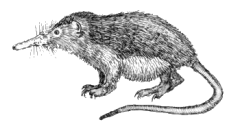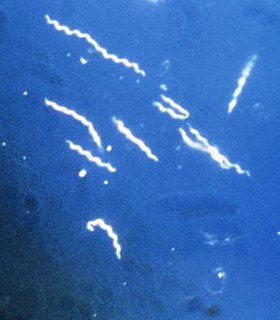
Shrews are small mole-like mammals classified in the order Eulipotyphla. True shrews are not to be confused with treeshrews, otter shrews, elephant shrews, or the West Indies shrews, which belong to different families or orders.

Bushmeat is meat from wildlife species that are hunted for human consumption. Bushmeat represents a primary source of animal protein and a cash-earning commodity for inhabitants of humid tropical forest regions in Africa, Latin America and Asia. Bushmeat is an important food resource for poor people, particularly in rural areas.

Babesiosis or piroplasmosis is a malaria-like parasitic disease caused by infection with a eukaryotic parasite in the order Piroplasmida, typically a Babesia or Theileria, in the phylum Apicomplexa. Human babesiosis transmission via tick bite is most common in the Northeastern and Midwestern United States and parts of Europe, and sporadic throughout the rest of the world. It occurs in warm weather. People can get infected with Babesia parasites by the bite of an infected tick, by getting a blood transfusion from an infected donor of blood products, or by congenital transmission . Ticks transmit the human strain of babesiosis, so it often presents with other tick-borne illnesses such as Lyme disease. After trypanosomes, Babesia is thought to be the second-most common blood parasite of mammals. They can have major adverse effects on the health of domestic animals in areas without severe winters. In cattle the disease is known as Texas cattle fever or redwater.

The red-toothed shrews of the subfamily Soricinae are one of three living subfamilies of shrews, along with Crocidurinae and Myosoricinae. In addition, the family contains the extinct subfamilies Limnoecinae, Crocidosoricinae, Allosoricinae and Heterosoricinae. These species are typically found in North America, northern South America, Europe and northern Asia. The enamel of the tips of their teeth is reddish due to iron pigment. The iron deposits serve to harden the enamel and are concentrated in those parts of the teeth most subject to wear.

The northern short-tailed shrew is the largest shrew in the genus Blarina, and occurs in the northeastern region of North America. It is a semifossorial, highly active, and voracious insectivore and is present in a variety of habitats like broadleaved and pine forests among shrubs and hedges as well as grassy river banks. It is notable in that it is one of the few venomous mammals. The specific epithet, brevicauda, is a combination of the Latin brevis and cauda, meaning "short tail".

The southern short-tailed shrew is a gray, short-tailed shrew that inhabits the eastern United States.

The Eurasian water shrew, known in the United Kingdom as the water shrew, is a relatively large shrew, up to 10 cm (4 in) long, with a tail up to three-quarters as long again. It has short, dark fur, often with a few white tufts, a white belly, and a few stiff hairs around the feet and tail. It lives close to fresh water, hunting aquatic prey in the water and nearby. Its fur traps bubbles of air in the water which greatly aids its buoyancy, but requires it to anchor itself to remain underwater for more than the briefest of dives.

Elliot's short-tailed shrew is a small, slate grey, short-tailed species of shrew. Its common name comes from Daniel Giraud Elliot, who first described the species in 1899.

Venomous mammals are animals of the class Mammalia that produce venom, which they use to kill or disable prey, to defend themselves from predators or conspecifics or in agonistic encounters. Venomous mammals are now rare. Mammalian venoms form a heterogeneous group with different compositions and modes of action, from three orders of mammals, Eulipotyphla, Monotremata, and Chiroptera. It has been proposed that some members of a fourth order, Primates, are venomous. To explain the rarity of venom delivery in Mammalia, Mark Dufton of the University of Strathclyde has suggested that modern mammalian predators do not need venom because they are able to kill quickly with their teeth or claws, whereas venom, no matter how sophisticated, requires time to disable prey.

The Siberian chipmunk or common chipmunk appears across northern Asia from central Russia to China, Korea, and Hokkaidō in northern Japan. Imported from South Korea and introduced in Europe as a pet in the 1960s, it is the only chipmunk found outside North America and is classed either as the only living member of the genus Eutamias, or as a member of a genus including all chipmunks.
Kallikreins are a subgroup of serine proteases, enzymes capable of cleaving peptide bonds in proteins. In humans, plasma kallikrein (KLKB1) has no known paralogue, while tissue kallikrein-related peptidases (KLKs) encode a family of fifteen closely related serine proteases. These genes are localised to chromosome 19q13, forming the largest contiguous cluster of proteases within the human genome. Kallikreins are responsible for the coordination of various physiological functions including blood pressure, semen liquefaction and skin desquamation.

Babesia, also called Nuttallia, is an apicomplexan parasite that infects red blood cells and is transmitted by ticks. Originally discovered by the Romanian bacteriologist Victor Babeș, over 100 species of Babesia have since been identified.

Lyme disease, or borreliosis, is caused by spirochetal bacteria from the genus Borrelia, which has 52 known species. Three main species are the main causative agents of the disease in humans, while a number of others have been implicated as possibly pathogenic. Borrelia species in the species complex known to cause Lyme disease are collectively called Borrelia burgdorferisensu lato (s.l.) not to be confused with the single species in that complex Borrelia burgdorferi sensu stricto which is responsible for all cases of Lyme disease in North America.
Andrew Spielman, Sc.D. was a prominent American public health entomologist and Professor of Tropical Public Health in the Department of Immunology and Infectious Disease at the Harvard School of Public Health (HSPH).

Ixodes scapularis is commonly known as the deer tick or black-legged tick, and in some parts of the US as the bear tick. It is a hard-bodied tick found in the eastern and northern Midwest of the United States as well as in southeastern Canada. It is a vector for several diseases of animals, including humans and is known as the deer tick owing to its habit of parasitizing the white-tailed deer. It is also known to parasitize mice, lizards, migratory birds, etc. especially while the tick is in the larval or nymphal stage.

The bicolored shrew or bicoloured white-toothed shrew is a species of mammal in the family Soricidae. It is found in eastern, central and southern Europe and in western Asia. It is a nocturnal species and feeds on insects and other small creatures. Several litters of young are born during the warmer months of the year in a nest of dry grasses in a concealed location.

Human granulocytic anaplasmosis (HGA) is a tick-borne, infectious disease caused by Anaplasma phagocytophilum, an obligate intracellular bacterium that is typically transmitted to humans by ticks of the Ixodes ricinus species complex, including Ixodes scapularis and Ixodes pacificus in North America. These ticks also transmit Lyme disease and other tick-borne diseases.
Soricidin is a paralytic oligopeptide found in the venomous saliva of the northern short-tailed shrew ; in the wild, shrews use it to paralyze their prey. Its name is a reference to "Soricidae", the family to which shrews belong.

Brevinema andersonii, named for John F. Anderson, who first described the organism. This organism is a Gram-negative, microaerophilic, helical shaped, chemoorganotrophic organism from the genus Brevinema. Brevinema andersonii is host associated, strains have been isolated from blood and other tissues of short-tailed shrews and white-footed mice and are infectious for laboratory mice and Syrian hamsters.B. andersonii is readily identified by restriction enzyme analysis, and SDS-PAGE, or fatty acid composition data. Another identifier for B. andersonii is the sheathed periplasmic flagella in the 1-2-1 configuration. While cells are visible by dark-field or phase-contrast microscopy, they cannot be seen when bright-field microscopy is used.














